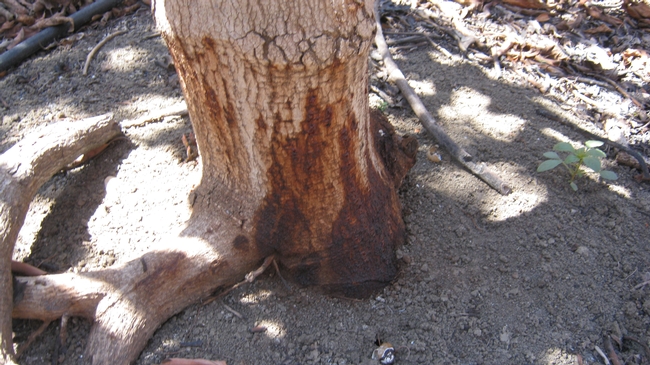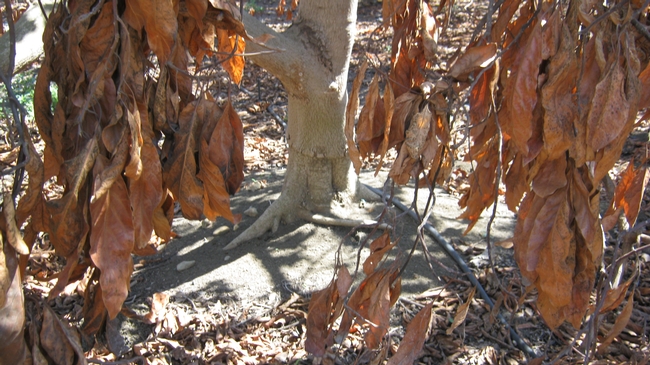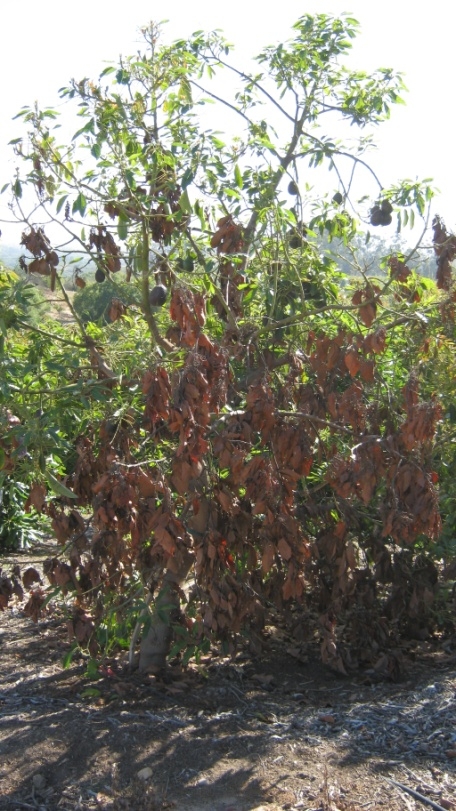
Posts Tagged: collapse
Assessing Fire Damage to Avocado
The destruction after a fire can be pretty gruesome and sad. Many times, though the fire moves through the orchard so fast that, even though the canopy has turned brown, there is a good chance the trees can come back. It all depends on how much damage has been done to the trunk. If the fire has substantially damaged the base of the trunk, it is unlikely to come back, even if the canopy is still green. That is the saddest thing, because you think you've dodged the bullet, but if the trunk is too damage, the canopy collapses gradually over a few weeks. However, the canopy may look a goner, but if the trunk is still intact, the tree will come back and may still be as productive as before.
The thing to look for at the base of the trunk is the discoloration. If it's black, it's probably not coming back. However, it can come back if after a few weeks you don't see the pencil-sized cankers that indicate that the sap has bubbled to the surface (see photo 1 below). If after a few weeks, the trunk is still clear of those bubbles (photo 2), even though the canopy looks gone, it is quite likely to come back.
It's also possible that the trunk may be damage in just one part of the trunk and not on the rest. In this case, it can also come back. The problem with these ones, is that they may come back and given enough time will be good trees again. But if they haven't recovered enough and there's a sudden heat spell, they may go down suddenly as if they had been burned again. That's the way they will look, like they have been burned again. Given enough time, though the avocado will grow from good areas to cover the poor areas and the tree may be productive again.
Avocados are amazing in their ability to recover. Eucalyptus can do it. But you singe the trunk of a lemon, and good-bye lemon.
Fire Information:
http://ceventura.ucanr.edu/Agricultural_Threats/Fire_Information/
Photo 1 and 2.

IMG 2040

IMG 2041
Citrus Sudden Collapse
This has been a hot time. Look for irrigation problems, but also look for other weather related problems. This is possibly the most shocking.
If you see your citrus tree suddenly collapse. It happens on a weekend or in a few days, and it has suddenly turned hot with a Santa Ana or Sundowner, it is quite likely "Dry Root Rot". This is a situation where the water conducting tissues, the xylem, have been clogged by fungi and when a sudden demand for water comes from the weather, the tree collapses because it can not support the movement of enough water to satisfy that demand. It is more common along the coast than the Valleyk, but it does occur there, as well.
It starts with some type of wound to the crown roots or stem - gophers or field mice nibbling away at the roots or crown. Or damage from weed whipping or some sort of mechanical damage. This allows entry of the Fusarium fungus that causes the xylem clogging. You can usually see the damaged tissue just below the bark, near the base of the tree. The damage has usually occurred several years prior and takes awhile for the fungus to do its clogging. There's no know cure for this situation. Cut the tree out. It's not particularly contagious as far as we know. The fungus is cosmopolitan, meaning it is found in most orchards, and it just waiting for a wound to invade. You can replant into the orchard, but just avoid causing wounding.
Dry root rot affects all citrus species and varieties.
http://ipm.ucanr.edu/PMG/r107100211.html
Photos:
Collapsed canopy, grapefruit
Dead tissue below the bark

dry root rot grapefruit canopy

dry root rot tissue
Citrus Dry Root Rot
Dry Root Rot is a pretty fantastic disease symptom that is usually seen in lemon, but can be seen in orange, as well.
Craig Kallsen, UCCE Citrus Advisor in Kern Co. comments on a disease sample:
I have seen a lot of dry root rot over the years. It usually is something that damages or weakens the root system which allows a Fusarium species to colonize the rootstock. It is very common in older lemon groves that froze at some point in their past. Also common in groves that suffered a lot of gopher damage or where the wraps got too hot in the sun burning the bark and cambium. I have also seen it in cases of fertilizer or other soil-applied chemical burn. I have no doubt that graft incompatibility could do it too.
Akif Eskalen, UCCE Plant Pathology Specialist chimes in on a disease sample submitted:
As you can see from the attached picture there is a weird callus formation and symptoms of incompatibility at the graft union which I think is the primary cause of decline. We didn't observe any discoloration in the scion, however rootstock was completely discolored where we isolated Fusarium solani the causal fungus of Dry Root Rot. Dry root rot caused by either Fusarium solani and/or Fusarium spp. When there is a disconnection at the graft union, the phloem can not transfer enough carbohydrate to the rootstock to feed feeder roots. Fusarium fungal species are present in the soil and they can attack and easily colonize on starch depleted roots and cause DRR.
We still don't know what is causing the graft incompatibility on these plants. That needs to be investigated.
It's still not clear how and why citrus becomes affected.

dry root rot
Honeybees are having a worse time than ever
By: Carey Gillam, Reuters
Honey bees, critical agents in the pollination of key U.S. crops, disappeared at a staggering rate over the last year, according to a new government report that comes as regulators, environmentalists and agribusinesses try to reverse the losses.
Losses of managed honey bee colonies hit 42.1 percent from April 2014 through April 2015, up from 34.2 percent for 2013-2014, and the second-highest annual loss seen, the U.S. Department of Agriculture said in a report issued on Wednesday.
"Such high colony losses in the summer and year-round remain very troubling," Jeff Pettis, a USDA senior entomologist, said in a statement.
The 2014-15 yearly loss was down slightly from the 45 percent annual loss for 2012-2013 but well above the prior two years of annual measurements and above the benchmark of 18.7 percent that is considered economically unsustainable, USDA said.
Millions of honey bees are relied on to pollinate plants that produce a quarter of the food consumed by Americans. Beekeepers travel the country with managed hives to help the process.
But over the past few years, bee populations have been dying at a rate the U.S. government says must be addressed, and finding an answer has become a politically charged debate.
Beekeepers, environmental groups and some scientists blame a class of insecticide known as neonicotinoids, or neonics, used on crops such as corn as well as on plants used in lawns and gardens.
But Bayer, Syngenta and other agrichemical companies that sell neonic products say many factors such as mite infestations are harming the bees.
The White House has formed a task force to study the issue, and some lawn and garden retailers have been cutting use of neonics.
The Environmental Protection Agency is requiring a series of studies on neonic effects on bees and plans to issue the first of a series of assessments later this year.
The USDA report issued on Wednesday said colony losses were 23.1 percent for the 2014-15 winter months, typically the higher loss period. The 2014 summer loss of 27.4 percent marked the first time summer losses exceeded winter, and marked a surge from the 2013 summer loss of 19.8 percent, USDA said.
The results are considered preliminary and are based on survey responses from about 6,100 beekeepers managing 400,000 colonies, USDA said. Those beekeepers represent nearly 15.5 percent of 2.74 million U.S. bee colonies. A more detailed report is to be published later this year, USDA said.

honeybee at hive
Stem and Leaf Blight
In both avocado and citrus there can be a rapid collapse of tissue brought on by a host of related fungi. The pathogen was once lumped as Dothiorella, but lately University of California extension plant pathologist Akif Eskalen has been able to tweeze out more species which mainly belong to the Botryosphaeria genus. The collapse can be quite rapid, so fast that the leaves continue to hang on to the tree. This disease is more common in years of low rainfall, where inadequate water is being applied (especially when Santa Ana winds are blowing), and where salinity build up has occurred. In the last 2 months, I have been called out to diagnose this problem five times. In each case, they were trees that had been sidelined and neglected or the grower was trying to save money by saving water. Luckily for a mature tree, there can be recovery as long the tree is protected from sunburn that occurs with defoliation. White wash the exposed parts, and wait for recovery. When it is clear what part is recovering, cut into fresh wood to remove the dead parts. For a more detailed discussion of this blight, see our 2009 Topics in Subtropics.


